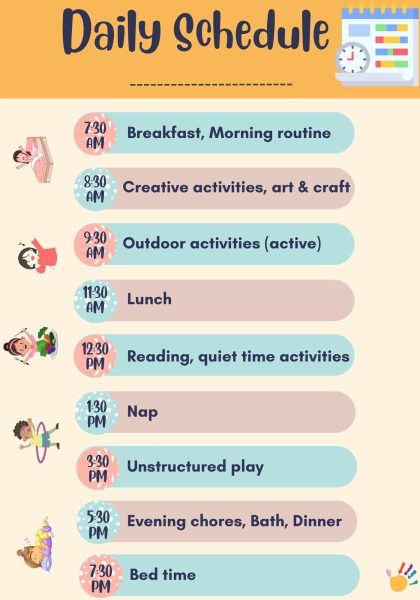CREATING A DAILY SCHEDULE FOR TODDLERS
A daily schedule can be the secret to a happy toddler and a happy home. Yes, it’s that useful. Waking up in the morning with an idea of what happens during the day or understanding what is expected of them really makes a toddler calmer and happier.
It’s a no-brainer. For us, also it’s the same. Imagine waking up not knowing what happens and unpredictable events keep coming at a pace you fail to respond to and process. It’s confusing, stressful, stressful and truly unpleasnt isn’t it?
Benefits of having a structured routine
- Daily activities are predictable
- Easy to plan
- Children are easy to transition to as they already know what happens next and are less likely to be stressed or confused.
- Children get enough time for sleep, rest and play.

Related Articles:
Sample Daily Schedule
Create a daily schedule from the sample below. Keep reading to find out the basics of creating a daily schedule and how to incorporate it into your daily routine.

The Basics of Creating a Daily Schedule for Toddlers

Understanding their sleep needs and patterns
Toddlers’ sleep needs are different from those of a baby or a school kid. Catering to their needs and planning to give them enough time for playtime and meal times is important for their wellbeing.
Recommended hours of sleep for different age groups
According to “Children’s Health Queensland“, different age categories of children need different ranges of sleep hours.
- 4-12 months -12-16 hours of sleep
- 1-2 Years – 11-14 hours
- 3-5 Years -10-13 hours
A consistent sleep pattern is ideal for kids because their bodies know when to wind down and fall asleep without any hassle.
Incorporating meal and snack times to THE DAILY SCHEDULE
It’s best to plan their main meals while keeping their sleep pattern in mind. You don’t want to see your toddler fall asleep while you are preparing his lunch or dinner.
Usually, two snack times should be great, with a good gap between main meals. But we all know that with kids , it can be 2 or 20 snack times sometimes. They have growth spurts, they are active and no wonder they are peckish most of the time.
Nutritional requirements for toddlers
By this stage, your little one can eat family meals. So all you have to do is keep offering balanced, nutritious meals every day and try to add variety to their meals.
Balancing meals and snacks throughout the day
Kids love to snack. But maintaining a gap between snack time and meal time is really important. If you schedule times for the main meal and snacking, it gets so much easier.
Tailoring the Daily Schedule to Your Toddler's Needs

Considering individual preferences and interests
By this time, you already know a lot about your little ones interests. Usually they like nursery rhymes, picture books, animals, vehicles, etc
Identifying your toddler’s favourite activities
You can offer them different types of toys and plan different activities to find out what they like best.
Visit an animal farm, a local library, indoor and outdoor playgrounds, a beach, arrange mud play or water play activities and see what your little one enjoys the most.
Incorporating their interests into the daily schedule
If your little one likes to help you in the kitchen, you may arrange a baking day once a week with them.
If they like outdoor play, you can go to local playgrounds.
Scheduling their favourite activities at least a couple of times a week is a great way to encourage them to engage and explore more of them.
Flexibility and adaptability
Recognising that routines may change as your toddler grows
Our little ones grow up so fast and their sleep patterns and interests may change with time.
They may drop their naptime altogether and move on to down-time activities when they are tired. As they grow older, they may show more and more interest in playing with peers, learning new social skills along the way.
You may have to arrange playdates, take them to social events for kids etc.
Adjusting the schedule to accommodate special circumstances or events
A daily schedule for toddlers makes life so much easier for you but remember that it’s not a rule that can’t be broken.
Be flexible wherever necessary and don’t make a big deal about it. Because life happens and things can get a bit out of place sometimes.
Having said that, try giving utmost priority to kids’ sleep and meal times because you know it’s impossible for them to function without these two.
Tips for Implementing and Maintaining a Daily Schedule for Toddlers

Consistency is key
Sticking to the established routine as much as possible
You may find it a lot easier when you stick to your schedule as much as possible. Kids may also absorb the importance given to it by adults and act accordingly.
Communicating the schedule to other carers or family members
This is something that you cannot do alone. So it’s really important that you communicate the schedule to your family and carers.
Allowing for free play and exploration
Remember that with kids you don’t have to be prepared all day every day. Give them time for free play, to be bored or make up their own games.
Giving toddlers opportunities for unstructured playtime
Give your toddler unstructured playtime. Give them the independence to choose what they do and how they do it.
You can sit back and keep an eye out. This can be the time when they learn to imagine and be creative.
Playing without adult participation helps them make decisions and be more confident.
Making adjustments as needed
- Monitoring your toddler’s behaviour and adjusting the schedule accordingly
- Seeking advice from healthcare professionals or child development experts
Conclusion
A toddler’s day can be super fun and relaxed if they are familiar with a schedule and have an idea of what comes next.
Even at that small age, kids show positive behaviour when their day is predictable and structured.
Take simple steps, start with a simple schedule for your toddler’s day and see the difference!!

Leave a Reply